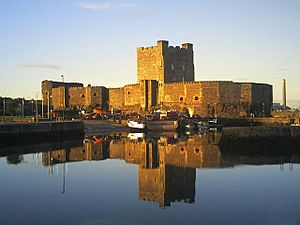Carrickfergus Castle facts for kids
Carrickfergus Castle is a famous Norman castle in Northern Ireland. It stands in the town of Carrickfergus in County Antrim, right on the northern shore of Belfast Lough. The castle's name comes from an old Irish phrase, Carraig Ḟergus, which means "Fergus's rock." Fergus was a strong leader from long ago.
This castle has seen a lot of history! Different groups like the Scottish, Irish rebels, English, and French all tried to capture it. Carrickfergus Castle was very important for military defense until 1928. It is still one of the best-preserved medieval buildings in Northern Ireland.
The castle was built in a smart spot. Originally, three-quarters of it were surrounded by water. Now, because of land reclamation (adding land where there was water), only one-third is surrounded by water. Today, the Department for Communities looks after it as a special historic monument.
Contents
Building the Castle: Its Beginnings
Carrickfergus Castle was built by John de Courcy in 1177. He was a Norman knight who had taken control of eastern Ulster. He made the castle his main base. John de Courcy ruled like a small king until 1204. Then, another Norman adventurer, Hugh de Lacy, took over.
At first, de Courcy built the inner part of the castle. This was a small area with strong walls and a main gate. It had several buildings inside, including a large hall. The castle was built on a rocky point that was almost completely surrounded by the sea. This position was perfect for controlling Carrickfergus Bay, which is now known as Belfast Lough. It also guarded the land routes into the town that grew up around the castle.
English Control and Changes
Carrickfergus Castle became very important to the English Crown. In 1217, a new castle manager, De Serlane, was given money to build a new outer wall. This wall would protect the castle from attacks coming from the land and from the sea at low tide.
Over time, parts of the middle wall were taken down. But the part facing the sea still stands. It has a small back gate and an east tower. This tower is special because it has many narrow openings for cross-bows at its base.
One room on the first floor of the east tower might have been the castle's chapel. It has beautiful windows in the Romanesque style. The main entrance passage has a strong arched ceiling and a "murder hole". This was a hole where defenders could drop things on attackers. There were also two heavy portcullis gates. These additions were started by Hugh de Lacy, but King Henry III finished them around 1250.
After 1333, the castle became the main home and office for the English in northern Ireland. During the Nine Years War (1595–1603), the castle's port was used to supply English soldiers. In 1597, a battle called the Battle of Carrickfergus happened nearby.
In the 1500s and 1600s, the castle was updated for artillery (cannons). They added special openings for cannons. But even with these changes, the castle was still attacked and captured many times. In 1689, Marshal Schomberg captured the castle after a week-long siege. This is also where King William III first landed in Ireland in 1690.
In 1760, after fierce fighting in the town, French invaders led by Francois Thurot took the castle. They looted the castle and town, then left. But the Royal Navy soon caught them.
The Castle's Later Life
In 1778, a small but important event in the American War of Independence happened here. John Paul Jones, a famous American naval commander, tricked a British Navy ship into leaving its safe spot near the castle. He then won an hour-long battle in the North Channel.
In 1797, the castle became a prison for war captives. It was heavily defended during the Napoleonic Wars. Six cannons from that time can still be seen on the east battery.
For about 100 years, the castle was used as a storage place for weapons and ammunition. During the First World War, it was a military base and a storage area. In the Second World War, it even served as an air raid shelter to protect people from bombs.
Carrickfergus Castle was continuously used by soldiers for about 750 years. In 1928, the British Army gave it to the new Government of Northern Ireland. They wanted to preserve it as an ancient monument. Many newer additions from after Norman times were removed to make the castle look more like it did originally.
Today, the castle is open to the public. The main banqueting hall has been fully restored. There are many exhibits that show what life was like in medieval times. This amazing castle was built and rebuilt many times, and it still stands strong today.
On his wedding day in 2011, Prince William of Wales was given the title of Baron Carrickfergus. This title is now just ceremonial and has no official connection to the castle itself.
Getting to the Castle by Train
The castle is just a short walk from Carrickfergus railway station. You can catch trains west to Belfast Lanyon Place and Belfast Grand Central. Trains also go east to Whitehead and Larne Harbour. These trains are run by NI Railways.
Images for kids
See also
 In Spanish: Castillo de Carrickfergus para niños
In Spanish: Castillo de Carrickfergus para niños




